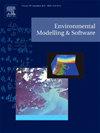Testing machine learning algorithms as post-processing tools for hydro-meteorological modelling over a small river basin
IF 4.6
2区 环境科学与生态学
Q1 COMPUTER SCIENCE, INTERDISCIPLINARY APPLICATIONS
引用次数: 0
Abstract
Accurate runoff forecasting in downstream urban areas of small river basins is crucial for flood warning and risk management. This study proposes a hybrid runoff forecasting framework that integrates a process-driven hydro-meteorological model with data-driven post-processing using ensemble machine learning (ML) algorithms. First, the MOLOCH meteorological model is used to predict weather conditions, and it is coupled with the FEST hydrological model, which translates meteorological output into hydrological responses. Finally, multiple ML algorithms are employed for error correction, and the results are integrated using the Stacking ensemble strategy. The case study indicates that: The Stacking model consistently outperforms traditional autoregression (AR) and long short term memory (LSTM) models in both overall accuracy and flood-event-specific performance metrics. Particularly, the post-processing framework exhibits comparable effectiveness when applied to both the coupled hydro-meteorological forecasting chain (CHMFC) and the FEST model, confirming its flexibility and potential to improve forecast lead time. While forecast performance naturally degrades over longer lead times, the Stacking model maintains better robustness and slower performance decay. The proposed hybrid framework combines the interpretability of process-driven models with the nonlinear capture capabilities of data-driven models, offering a promising solution for enhancing real-time runoff forecasting in flood-prone small river basins.
测试机器学习算法作为小流域水文气象建模的后处理工具
小流域下游城市地区准确的径流预报对洪水预警和风险管理至关重要。本研究提出了一种混合径流预测框架,该框架使用集成机器学习(ML)算法将过程驱动的水文气象模型与数据驱动的后处理相结合。首先,MOLOCH气象模型用于预测天气状况,并与FEST水文模型相结合,后者将气象输出转化为水文响应。最后,采用多种机器学习算法进行纠错,并采用堆叠集成策略对结果进行集成。案例研究表明:在总体精度和洪水事件特定性能指标方面,堆叠模型始终优于传统的自回归(AR)和长短期记忆(LSTM)模型。特别是,后处理框架在应用于水文气象耦合预报链(CHMFC)和FEST模式时表现出相当的有效性,证实了其灵活性和提高预报提前期的潜力。虽然预测性能在较长的交付周期内自然会下降,但堆叠模型保持更好的鲁棒性和较慢的性能衰减。提出的混合框架将过程驱动模型的可解释性与数据驱动模型的非线性捕获能力相结合,为加强洪水易发小河流流域的实时径流预测提供了一个有希望的解决方案。
本文章由计算机程序翻译,如有差异,请以英文原文为准。
求助全文
约1分钟内获得全文
求助全文
来源期刊

Environmental Modelling & Software
工程技术-工程:环境
CiteScore
9.30
自引率
8.20%
发文量
241
审稿时长
60 days
期刊介绍:
Environmental Modelling & Software publishes contributions, in the form of research articles, reviews and short communications, on recent advances in environmental modelling and/or software. The aim is to improve our capacity to represent, understand, predict or manage the behaviour of environmental systems at all practical scales, and to communicate those improvements to a wide scientific and professional audience.
 求助内容:
求助内容: 应助结果提醒方式:
应助结果提醒方式:


